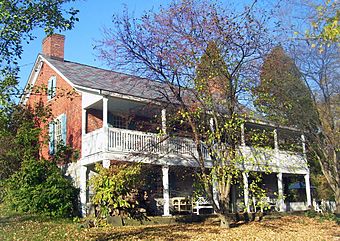Ezra Clark House facts for kids
|
Ezra Clark House
|
|
|
U.S. Historic district
Contributing property |
|

South elevation and east profile, 2008
|
|
| Location | North East, NY |
|---|---|
| Nearest city | Hudson |
| Area | 8.7 acres (3.5 ha) |
| Built | ca. 1780 |
| Part of | Coleman Station Historic District |
| NRHP reference No. | 85000338 |
Quick facts for kids Significant dates |
|
| Added to NRHP | February 21, 1985 |
| Designated CP | cp |
The Ezra Clark House is a historic brick house located in the town of North East, New York, United States. It was built a long time ago, in the late 1700s.
This house is special because it's one of the oldest farmhouses in the town. It's also one of the few old houses in the area made of brick. In 1985, the Ezra Clark House was added to the National Register of Historic Places. This is a list of important historical places in the United States. Later, in 1993, it was recognized again when the Coleman Station Historic District was created. This means it helps make the whole historic area special.
Contents
Exploring the Ezra Clark House and Its Land
The Ezra Clark House sits on about 8.7 acres of land. It's located on the west side of Mill Road, near Indian Lake Road. A picket fence stands in front of the house. Behind the house, the property line follows an old railroad path, which is now the Harlem Valley Rail Trail.
Most of the land around the house is open fields or wet areas. There's also a small pond south of the house. Besides the main house, there's a barn and a shed to the north. You can also find a gazebo near the pond. These other buildings are not considered part of the house's original historic value.
What Does the House Look Like?
The main part of the house faces south. It has a stone basement that shows on the south and west sides. The house itself is two stories tall and made of brick. It has a pointed roof covered with colorful slate shingles. Two brick chimneys stick out from the roof.
The front of the house has a wide wooden porch on both floors. This porch is held up by columns. The way the land slopes means that the back part of the first floor is actually underground.
All the windows have wooden shutters with their original metal parts. The windows on the second floor are evenly spaced. However, the windows on the ground floor are not. The two windows next to the front door have brick arches above them.
The windows on the sides of the house are placed unevenly. On the upper back side, there's a door in the middle with a brick arch. To the east of this door, there's a larger window that was added later. The two windows on the west side are original to the house and also have brick arches.
Inside the Historic Home
When you enter the house through the main door, you step into a central hallway. There are two rooms on each side of this hall. The rooms on the west side have fireplaces in the corners. The front room on the west side has an exposed beam ceiling.
The front room on the east side was the original kitchen. It has a large fireplace in the side wall. There's also a Dutch beehive oven here. The fireplace's mantelpiece (the shelf above the fireplace) is original. The room at the back on the east side has been changed to include a modern bathroom. A staircase inside the old kitchen leads upstairs to bedrooms and a modern kitchen. The garret (the space just below the roof) has been divided into two more bedrooms.
The History of the Ezra Clark House
For a long time, people thought Ezra Clark built this house. They also believed it was the oldest house in the Millerton area. But a brick in the chimney has the letters "J.M. 1780" carved into it. This suggests the house was built later than first thought, and by someone else.
The most likely person for "J.M." is Jacob Meyers. He was a lieutenant in the Continental Army during the American Revolution. His family moved to the Millerton area around 1780. They came from a small community called Pulvers Corners.
The Ezra Clark House is a good example of a typical Hudson Valley brick house. It shows influences from both English and Dutch vernacular architecture (local building styles). For example, the porch and the central hall layout are common features from these traditions.
Ezra Clark and his family, who had lived in the area for a long time, moved into the house around 1795. The farm used to be much larger than it is today. Over the years, later owners added some windows and changed the roof material several times. However, the house still looks and feels much like it did when it was first built. It has kept most of its original design and materials.



